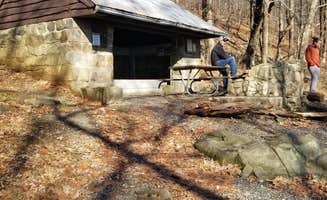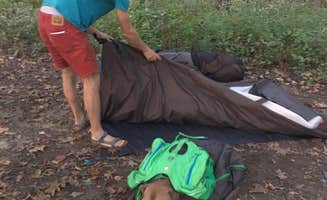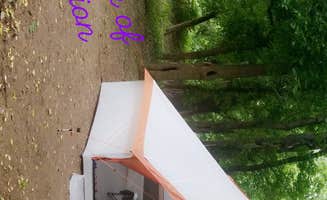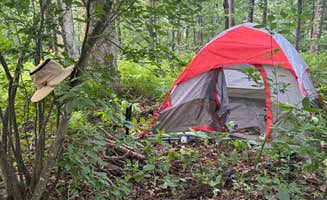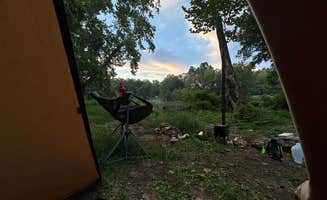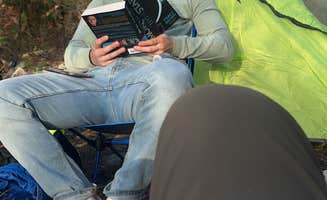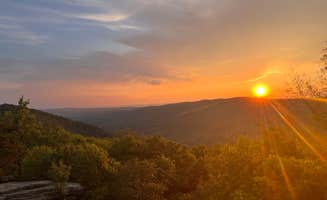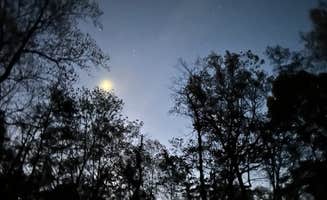Dispersed camping near Elkwood, Virginia offers numerous backcountry experiences in elevations ranging from 600 to 4,000 feet across Shenandoah National Park and George Washington National Forest. Winter temperatures can drop below freezing at higher elevations, while summer brings temperatures in the 80s and frequent afternoon thunderstorms. Primitive camping options include both roadside sites and multi-mile backpacking destinations requiring various levels of hiking experience.
What to do
Hike to mountain viewpoints: The Veach Gap trail in George Washington National Forest provides excellent ridge hiking with minimal crowds. "Breathtaking views of the Shenandoah River and surrounding mountains. Very much worth the 4 mile hike up to the site. 1,200ft elevation difference from the trailhead to the site," notes a Veach Gap camper.
Explore waterfalls: Several trails lead to seasonal waterfalls, particularly during spring months. "I stayed in the area of overall run falls. Make sure to hang your food. There are plenty of black bears in the area," reports a backpacker at Shenandoah National Park Dispersed Sites.
Fish in mountain streams: South Fork Shenandoah River offers fishing opportunities with convenient access points. "The road to get to the campsite was well maintained and easy to get to. Campsites themselves were a tad overgrown but it was the beginning of the season," notes a spring visitor to the river area.
What campers like
Rustic camping infrastructure: Some dispersed sites include basic amenities. "You select a campsite by flipping a washer on a hook on the board from green to red. Flip it back when you leave. The campsites have a fire ring, a picnic table, and a flat area to pitch a tent," explains a camper at Little Fort Campground.
Wildlife viewing opportunities: Animal sightings are common throughout the camping areas. "About as flat as you'll get, the hike here was nice. It's a decently private spot with the trail close by, bugs weren't bad only gripe was bears were constantly checking out our tent during night," reports a visitor to Laurel Prong Trail.
Trail connectivity: Many dispersed sites connect to longer trail networks. "I've both day hiked this and backpacked here several times. You will want to drive in and park at the Veach Gap Trailhead which is listed on Google Maps, then follow the trail and make the left when it comes to the intersection," explains an experienced Veach Gap camper.
What you should know
Limited facilities: Most sites have minimal or no amenities. "There are 9 campsites, each with at least one fire ring, a tent pad and a picnic table, and there is a vault toilet in the middle," notes a Little Fort Campground reviewer, which is more developed than most options.
Cell service gaps: Connectivity is extremely spotty throughout the region. "Note: this page says that Verizon has limited service but I have a Verizon prepaid plan and I had no service at all starting from about 20 minutes away from the site, so I wouldn't count on having any reception," warns a Little Fort visitor.
Seasonal road closures: Many forest roads close during winter or after heavy precipitation. "Some roads were closed. Some spots were full of trash," reports a visitor to Crisman Hollow Road Camp, highlighting the importance of checking road conditions.
Water availability: Streams may dry up during summer months. "It is about 4 miles up, so not too bad, but there is no water after the first mile. I have seen a small trickle part way up the mountain, but don't count on it. Pack up all the water you will need for the day/evening/morning," advises a Veach Gap camper.
Tips for camping with families
Choose established sites: For families with younger children, campgrounds with basic facilities work best. "This is a nice little spot. You select a campsite by flipping a washer on a hook on the board from green to red. Flip it back when you leave. The campsites have a fire ring, a picnic table, and a flat area to pitch a tent," notes a Little Fort visitor.
Plan for wildlife encounters: Bears are active throughout the region. "We not only saw bear scat all around, we saw an adorable black bear cub run off into the woods along the Piney Branch Trail. Never saw mama bear, but hoped that she was where the little one was heading," reports a Shenandoah National Park backpacker.
Consider seasonal timing: Spring and fall provide milder temperatures. "Went up in November with beautiful weather, fall leaves changing and great company. Couldn't have had a better experience," shares a Veach Gap camper about their autumn trip.
Tips from RVers
Access limitations: Most dispersed camping areas have narrow, rough roads unsuitable for larger vehicles. "The site was wonderful! Not too many spaces so it can fill up quick. There is a launch in the middle, so there is a bit of come and go," explains a visitor to South Fork Shenandoah River, one of the few areas accessible to smaller RVs.
Prepare for limited hook-ups: No dispersed camping areas offer electricity or water connections. "Bathrooms had no TP so bring your own, and please remember to pack out your trash! Plenty of firewood from downed trees, sites are dirt which makes staking down easy, but I can imagine it would be muddy if it rains," notes a South Fork Shenandoah River camper.
Weather considerations: Seasonal flooding can affect river sites. "I went back early October to possibly camp again, shortly after the hurricane rains had passed. The sites were underwater or filled with river mud, making them completely un-campable. Just keep this in mind when you go out," warns a South Fork Shenandoah River visitor.


